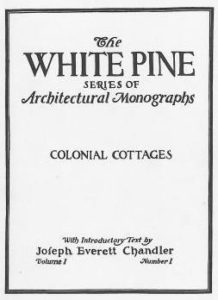The White Pine Bureau was formed in 1915 to carry on an advertising campaign on behalf of the White Pine manufacturing industry (of the time) that would be supported by an assessment on their total lumber production. The Bureau represented two White Pine organizations; The Northern Pine Manufacturers Association of Minnesota, Wisconsin, and Michigan; and The Associated White Pine Manufacturers of Idaho. These trade organizations were located within the Upper Midwest and Northwestern regions of the U.S. and dominated by various mills and businesses owned by Weyerhaeuser Forest Products. The headquarter office of the Bureau was located in St. Paul, Minnesota.
The flagship promotional piece developed by the Bureau was the White Pine Series of Architectural Monographs, a publication whose purpose was to encourage the use of white pine as a building material. The Bureau hired Russell F. Whitehead as the publication’s editor who was well known within the early years of design and construction type journals. He had been named editor of The Architectural Record in 1912 and the Brickbuilder in 1913.
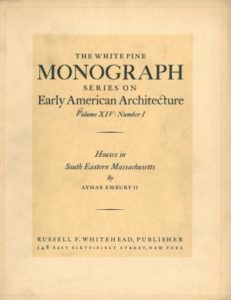 Following the 1915 start-up of the Monographs with 3 issues, the frequency was increased to 6 issues a year (expect for 5 in 1919). Each publication featured early American buildings made of white pine, inside and out. A general architectural style of building such as Colonial Cottages, or structures in a specific town (Portsmouth), or specific architectural elements that included doorways and mantels would make up each publication. Periodic design contests were also part of the Monograph history where specific end use structures made up the design criteria. This included the design of a Roadside Tavern and a home of Eastern White Pine that would cost $12,500.
Following the 1915 start-up of the Monographs with 3 issues, the frequency was increased to 6 issues a year (expect for 5 in 1919). Each publication featured early American buildings made of white pine, inside and out. A general architectural style of building such as Colonial Cottages, or structures in a specific town (Portsmouth), or specific architectural elements that included doorways and mantels would make up each publication. Periodic design contests were also part of the Monograph history where specific end use structures made up the design criteria. This included the design of a Roadside Tavern and a home of Eastern White Pine that would cost $12,500.
The high quality photographs, for the time, and the measured drawings of buildings and features made the series a popular success with its audience. Over 9,800 architects and architectural designers received the Monographs at its peak. Public libraries and universities around the country also received the publication. Curiously, while the Bureau supporters were all located in the Upper Midwest and Western U.S., the content within the Monographs were locations exclusively within the Eastern, Mid-Atlantic, and even some Southern geographic locations of the country.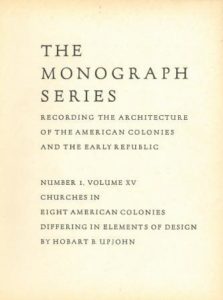
After 10 years of support for the Monograph Series, the White Pine Bureau ended its sponsorship of the publication after the last issue of 1924. At that time, the editor, Russell F. Whitehead took over the Series as both editor and publisher with the assistance and financial support of Weyerhaeuser Forest Products Company through full-page advertisement insertions. Mr. Whitehead also became editor of the architectural journal, Pencil Points in 1924 in addition to working as a practicing architect with the firm of Clark & Whitehead.
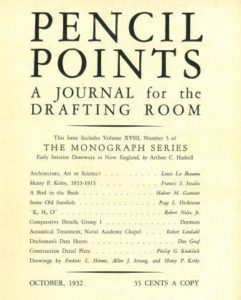 In 1928, the title of the publication changed to The White Pine Monograph Series on Early American Architecture, which changed again in 1929 to The Monograph Series – Recording the Architecture of the American Colonies and the Early Republic. And at the end of 1931, the publication ceased to be published as a stand-alone printing after 98 issues. In 1932, the series was absorbed into the previously-mentioned Pencil Points journal as a 10-15 page insert, where Mr. Whitehead remained as editor until 1940. These inserts were of single, architectural topic focus and appeared in this monthly magazine approximately 6 times per year. In 1941, the original series disappeared altogether from print. Pencil Points merged with Progressive Architecture in 1943 to become “the leading voice in architectural and graphic design when modernism flourished, introducing key players from America and Europe”.
In 1928, the title of the publication changed to The White Pine Monograph Series on Early American Architecture, which changed again in 1929 to The Monograph Series – Recording the Architecture of the American Colonies and the Early Republic. And at the end of 1931, the publication ceased to be published as a stand-alone printing after 98 issues. In 1932, the series was absorbed into the previously-mentioned Pencil Points journal as a 10-15 page insert, where Mr. Whitehead remained as editor until 1940. These inserts were of single, architectural topic focus and appeared in this monthly magazine approximately 6 times per year. In 1941, the original series disappeared altogether from print. Pencil Points merged with Progressive Architecture in 1943 to become “the leading voice in architectural and graphic design when modernism flourished, introducing key players from America and Europe”.
In 2006, the Northeastern Lumber Manufacturers Association (NELMA) resurrected the Series as part of their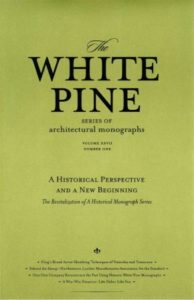 marketing and communications program on behalf of the Eastern White Pine manufacturing membership. The “new” series maintains the look and feel of the original publication, while bringing today’s trends and examples into reference regarding the use of this sustainable and versatile wood species. The White Pine Bureau was far ahead of its time when it created the White Pine Monograph Series for marketing purposes in 1915. With the original series lasting 27 years, this fascinating publication continues to be of interest today within the architecture and building design community.
marketing and communications program on behalf of the Eastern White Pine manufacturing membership. The “new” series maintains the look and feel of the original publication, while bringing today’s trends and examples into reference regarding the use of this sustainable and versatile wood species. The White Pine Bureau was far ahead of its time when it created the White Pine Monograph Series for marketing purposes in 1915. With the original series lasting 27 years, this fascinating publication continues to be of interest today within the architecture and building design community.
NELMA is pleased to house all of the original, historic 98 booklets along with the issues published since 2006 within its reference library. We gladly extend the Series availability by providing each of these online for reading, with printing capabilities.
- All
- Monographs
1915 – Volume I
Vol I Issue I Colonial Cottages
Vol I Issue II – Colonial Houses
Vol I Issue III – Farm Houses of New England
1916 – Volume II
Vol II Issue I – Houses of the Middle and Southern Colonies
Vol II Issue II – Domestic Architecture in Massachusetts 1750-1800
Vol II Issue III – Early Houses of the Connecticut River Valley
Vol II Issue IV – A Suburban House and Garage – to cost ten thousand dollars
Vol II Issue V – Old Woodbury and Adjacent Domestic Architecture in Connecticut
Vol II Issue VI – Colonial Architecture of the Eastern Shore of Maryland
1917 – Volume III
Vol III Issue I – Three Story Houses
Vol III Issue II – Early Wooden Architecture of Andover Massachusetts
Vol III Issue III – Homes of Newburyport Massachusetts
Vol III Issue IV – A White Pine House
Vol III Issue V – The Bristol Renaissance
Vol III Issue VI – The Early Dwellings of Nantucket
1918 – Volume IV
Vol IV Issue II – Some Old Houses on the Coast of Southern Maine
Vol IV Issue IV – Vacation Season
Vol IV Issue V – Central New York
1919 – Volume V
Vol V Issue I – Seventeenth Century Connecticut Houses
Vol V Issue II – Eastern End of Long Island
Vol V Issue III – Historical Houses of Litchfield
Vol V Issue IV – Community Centre Building
1920 – Volume VI
Vol VI Issue I – The Boston Post Road
Vol VI Issue II – A New England Village
Vol VI Issue III – Lower Delaware Valley
Vol VI Issue IV – Designs for a Roadside Tavern
Vol VI Issue V – Old Deerfield
Vol VI Issue VI – Essex Connecticut
1921 – Volume VII
Vol VII Issue I – Portsmouth New Hampshire
Vol VII Issue II – Early American Doorways
Vol VII Issue III – Greek Revival in Owego and NY
Vol VII Issue IV – Design for a Three Teacher School
Vol VII Issue V – Early American Doorways Pt 2 Porches
Vol VII Issue VI – The Town of Suffield Connecticut
1922 – Volume VIII
Vol VIII Issue I – Port Towns of Penobscot Bay
Vol VIII Issue II – Dependencies of the Old Fashioned House
Vol VIII Issue III – Newport Rhode Island
Vol VIII Issue IV – Designs for a Country Church and Sunday School
Vol VIII Issue V – Bennington Vermont
Vol VIII Issue VI – Fences and Fence Post of Colonial Times
1923 – Volume IX
Vol IX Issue I – Forgotten Farmhouses on Manhattan Island
Vol IX Issue II – The River Towns of Connecticut
Vol IX Issue III – Cooperstown
Vol IX Issue IV – Designs for a Rural Library Building
Vol IX Issue V – The Stage Coach Road
Vol IX Issue VI – Old Canterbury on the Quinnebaug
1924 – Volume X
Vol X Issue I – Old Hill Towns of Windham Connecticut
Vol X Issue II – Ornamental Cornices Pt.1
Vol X Issue III – Ornamental Cornices Pt.2
Vol X Issue IV – Rensselaerville
Vol X Issue V – Wooden Architecture in the Berkshires
Vol X Issue VI – A Review and Forecast
1925 – Volume XI
Vol XI Issue I – Connecticut Valley Colonial
Vol XI Issue II – Interior Woodwork in New England
Vol XI Issue III – Dutch Houses of New Jersey
Vol XI Issue IV – Late Eighteenth Century in Western Massachusetts
Vol XI Issue V – Country Meeting Houses
Vol XI Issue VI – George Read II House
1926 – Volume XII
Vol XII Issue I – New Castle Delaware
Vol XII Issue II – Farmington Connecticut
Vol XII Issue III – The Burlington County Court House
Vol XII Issue IV – Alexandria Virginia
Vol XII Issue V – Early Dwellings in New Hampshire
Vol XII Issue VI – Wiscasset Maine
1927 – Volume XIII
Vol XIII Issue I – New Bern Pt. 1
Vol XIII Issue II – New Bern Pt. 2
Vol XIII Issue III – A Eastern North Carolina Town House
Vol XIII Issue IV – Moravian Architecture of Bethlehem Pennsylvania
Vol XIII Issue V – Col. Robert Means House NH
Vol XIII Issue VI – Churches of Vermont
1928 – Volume XIV
Vol XIV Issue I – Houses in Southeastern Massachusetts
Vol XIV Issue II – Old Charleston
Vol XIV Issue III – A Townhouse of Charleston SC
Vol XIV Issue IV – Charleston Mansions
Vol XIV Issue V – Charleston Doorways
Vol XIV Issue VI – Edwards-Smyth House Charleston SC
1929 – Volume XV
Vol XV Issue I – Churches in Eight Colonies
Vol XV Issue III – The House of John Imlay
Vol XV Issue IV – A Pre-Revolutionary Annapolis House Pt.1
Vol XV Issue V – A Pre-Revolutionary Annapolis House Pt.2
Vol XV Issue VI – Annapolis on the Seventh
1930 – Volume XVI
Vol XVI Issue I – Montpelier the Snowden-Long House
Vol XVI Issue II – Early American Windows
Vol XVI Issue III – Gunston Hall Fairfax County Virginia
Vol XVI Issue IV – Colonial Maryland
Vol XVI Issue V – Wye House Talbot County Maryland
Vol XVI Issue VI – Public Buildings Pt.1
1931 – Volume XVII
Vol XVII Issue I – The Builders Companion Pt.1
Vol XVII Issue II – The Builders Companion Pt.2
Vol XVII Issue III – Architectural Inspiration from Northern Virginia
Vol XVII Issue IV – The Charm of Old San Antonio
Vol XVII Issue V – Anne Arundel County Maryland
Vol XVII Issue VI – Small Colonial Houses
2006-08 – Volume XXVII
Vol XXVII Issue I – A Historical Perspective
Vol XXVII Issue II – Modern Applications of Historical Species
Vol XXVII Issue III – White Pine Adds to Island Living Ambiance
2009 – Volume XXVIII
Vol XXVIII Issue I – Portsmouth New Hampshire
Vol XXVIII Issue II – Sustainable Versatility
2010 – Volume XXIX
Vol XXIX Issue I – New Milford
Vol XXIX Issue II – Newburyport
2011 – 2014 Volume XXX
Vol XXX Issue I – Sandwich New Hampshire
Vol XXX Issue II – Lumber and Sons
Vol XXX Issue III – Making the Grade
2014 – Volume XXVI (XXXI)
Vol. XXVI – The Next Generation – Architectural Students Design to Feature Eastern White Pine

